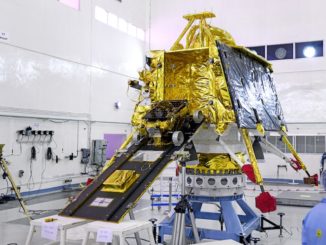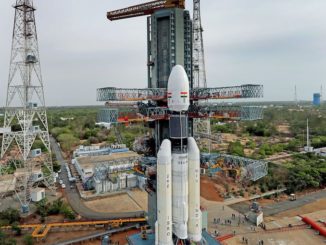
Updated to include the new target landing time.
Achieving a successful lunar landing becomes increasingly more tangible for the team at Intuitive Machines with each passing day since launch. On Wednesday, the Houston-based company announced that it was able to place its robotic lunar lander, named Odysseus, into a 92 km circular orbit around the Moon, clearing the way for a landing attempt on Thursday.
In a social media post, Intuitive Machines said the lander’s main engine burned for 408 seconds to complete the maneuver to enter orbit.
“Initial data indicates the 800 [meters per second] burn was completed within 2 m/s accuracy,” the company stated. “Over the next day, while the lander remains in lunar orbit, flight controllers will analyze the complete flight data and transmit imagery of the Moon.”
The mission thus far is helping to prove out the viability of a propulsion system powered by a combination of liquid oxygen and liquid methane. Trent Martin, the vice president of Space Systems for Intuitive Machines, said IM chose this propellant mixture for its main engine because the company believes it’s “the future of this technology.”
“The second reason we chose it is because we can test it so easily. We test it in our flame range in Houston regularly. We’ve done over 150 rocket fires on multiple iterations of this engine,” Martin said in the run-up to the Feb. 15 launch. “We’ve taken the engine that’s sitting on that spacecraft, with that spacecraft, and fired it as a test fire to prove that that engine will light on the vehicle.”
Martin and the team were able to give it a good in-space test when they performed a checkout burn called the “commissioning maneuver” (CM). That was a 21-second, full-thrust firing of the main engine on Feb. 16.
Originally, the CM was set to occur about 18 hours after launch, however, IM decided to delay that burn. It said the flight teams “experienced intermittent uplink and downlink data communications between Nova-C and the ground stations, potentially impacting our ability to collect the critical information required to support the CM burn and follow-on performance analysis.”
Martin said prior to the IM-1 launch that getting through this milestone would be a big sigh of relief.
“It takes the stress level down a little bit. It brings the probability of success up a little bit,” Martin said.
https://twitter.com/Int_Machines/status/1760323743270756500
Moment of truth
The biggest test for the landing is coming up on Thursday when IM flight teams command Odysseus to exit its circular lunar orbit and make its landing attempt. Martin said the lander’s engine went through extensive throttle testing to make sure it was ready for the big day.
“That’s extremely important because as you go to land on the surface of the Moon, you’re going to lose two-thirds of the mass that you started with, you’re going to lose it as you burn it up,” Martin explained. “So, you have to be able to throttle back that engine to a much lower level than the 100 percent that you started with.
“But being able to take that engine and run it that entire time means that you never turn your engine off. So you never have that fear that ‘is it going to light that next time?’ because it’s lit and it stays lit all the way to the surface. And that’s what makes the technology that we’re flying different than some of our competitors have.”

That final burn will not only slow down Odysseus to prepare it for landing, but teams will also reorient the spacecraft to shift from a somewhat horizontal position into a vertical one for descent.
“We will perform a descent orbit insertion where our terrain relative navigation device will help us perform our powered descent initiation, a pitch over of our main engine where our main engine will fire as we do our hazard detection avoidance and vertical descent, terminal descent and landing on the Moon,” Martin explained in a pre-launch press conference.
He said that the autonomous landing sequence and the descent orbital insertion (DOI) occurs about an hour before the landing. Touchdown at Malapert A, a crater about 10 degrees from Moon’s south pole, is scheduled for 6:24 p.m. EST (2324 UTC) on Thursday, Feb. 22.
Once on the lunar surface, Martin said they expect Odysseus to operate for seven days before lunar night arrives and the lander loses power as it is enveloped in cold darkness.
Shot on goal
This landing attempt marks a big next step for NASA’s Commercial Lunar Payload Services (CLPS) program. The agency paid just under $118 million for IM to fly six of its science instruments to the Moon’s surface. NASA spent under $11 million to develop and build them prior to their integration on the lander.
One of the tools, the Radio Frequency Mass Gauge (RFMG), has been working along the flight path to the Moon to assess the propellant levels within the lander. Joel Kearns, the deputy associate administrator for NASA’s Science Mission Directorate, said it will be important to learn how to monitor fuel levels for future deep space missions.
“When you’re just up in space and microgravity, when you’re not propulsively thrusting, the liquid fuel and oxidizer doesn’t necessarily go to the bottom of the tank where it would on a car, where you could just pull it into the engine,” Kearns said. “You have to find a way to get it there and you have to find a way to know how much do you have left based on what you use, other than just measuring how much you pull out versus how much you put in it originally.”

The IM-1 mission is the second CLPS venture attempting Moon landing so far. Last month, Astrobotic’s Peregrine lunar lander failed to reach the Moon after it encountered an issue with its propulsion system.
Both Astrobotic and IM have other CLPS missions planned for later this year. Martin said they are currently working with NASA to determine the precise landing location for their next mission: IM-2.
“We’re landing probably on the Shackleton Connecting Ridge, which is right, as close as you can get to the South Pole without landing right on the Shackleton Rim, which would be really difficult to land on,” Martin said. “There are points on that ridge where you get a lot of light, but maybe the next year, you don’t get light in that same spot, so you have to move a couple hundred meters this way or a couple hundred meters that way.
“So, we’ve been trying to negotiate on that exact site. Once we get that, then we can pick the landing dates and times. Our goal is fourth quarter of this year for that next mission and then the follow-on mission will follow that, based on that second one going in fourth quarter of this year.”
That mission will feature a partnership with Nokia, which will debut what it calls “the first cellular network on the Moon” as part of NASA’s Tipping Point initiative.




